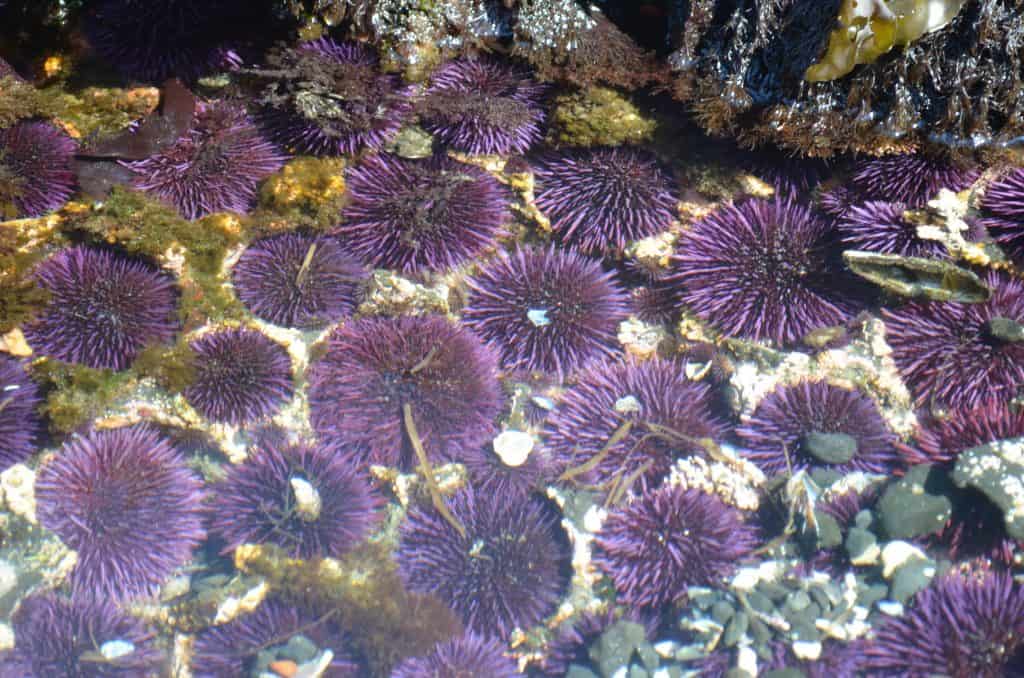It’s no secret that the Pacific Coast is one of my absolute favorite places in the USA to road trip. Below are some of the animals in the tidal pools that you’ll see on the Oregon Coast as well as up and down the Pacific Coast.

Ochre Sea Star

These big purple and orange starfish are always my favorite to look for on the Oregon coast tidal pools! The further north I travel on the coast the more I tend to see although you can find these sea stars along the entire coastline.
Definitely look for them at Canon Beach and the northern areas of the Oregon coast clinging to rocks!
Fun Facts about the Ochre Sea Star:
- Its Latin name is Pisaster ochraceus.
- They come in purple, orange and brownish-red.
- Scientists aren’t sure how the sea star gets its colors.
- Ochre sea stars can live for over 20 years!
- They eat barnacles, snails, limpets and mussels.
Sea Slater:

If you’re looking for sea slaters you’ll be looking for cliffs on Oregon coastal beaches like Seal Rock and Ecola Beach State Park where sea slaters love to hide inside the cracks. (Although they can be found along the entire Oregon coastline.
These are very skittish creatures and it took me quite a while to get the photo I did above as they move quickly! These critters tend to hang out in rock crevices at around high tide lines so don’t look too low if you’re searching for them.
Fun Facts About the Sea Slater:
- Its Latin name is Ligia pallasi.
- Also known as a rock louse or sea roach.
- Sea Slaters are isopods.
- They breathe using pleopods which require the animal to stay moist.
- They live up to 2 years.
Check out this interactive map to see where Sea Slaters live!
Giant Green Anemone:

Giant green anemone are easy to spot and prolific along the Oregon coastline! These were easiest and the first wildlife for my children to spot along the coastline as we drove up the Pacific Coast Highway.
If you gently lay your one finger on the top of the anemone you can watch it’s sticky feeling tentacles close up around your finger. You are triggering it’s response to capture its prey.
Fun Facts about the Giant Green Anemone:
- Its Latin name is Anthopleura xanthogrammica.
- They can be found as far north as Alaska and as far south as Mexico.
- It mostly eats small fish, crabs and mussels.
- They use stinging cells to capture prey (although they are harmless to humans).
Purple Sea Urchin:

These fragile beauties are a little harder to spot in tidal pools than anemone but just as beautiful! You never know when you peer over that next rock into a tidal pool when you’ll find an army of purple sea urchins!
Fun Facts about the Purple Sea Urchin:
- Purple sea urchins are edible! People eat the meat inside called uni.
- Sea otters and sea stars also eat purple sea urchins.
- Overpopulation of purple sea urchins are damaging California’s kelp forests.
- Purple sea urchins can “walk”.
- The toothlike plates that surround an urchin’s mouth are called “Aristotle’s lantern.”
Crabs:

Shore crabs: (like the one shown above)
Shore crabs are the most common crabs found on the coastline. These guys can be found both in the water and on the shore!
Hermit crabs:
Contrary to popular belief hermit crabs can actually smell dead or dying snails and then will use their shells as a home, they do not kill snails for their shell. Although they may battle other hermit crabs over the same shell.
As hermit crabs grow larger they need to continually find larger shells. They are also nocturnal which makes them hard to be found on the shore line!
Sand crabs:
Sand crabs look far different than your typical “crab” appearance you might expect, and can be found burrowing in the shifting sand of the shore line under the waves. These wave breaks bring fresh plankton which is food for the sand crab.
You can actually monitor the health of a beach based on the sand crabs. It is also referred to as the Pacific Sand Crab or Mole Crab. DID YOU KNOW? Sand crabs can only move backwards! Not side to side or forward!
Other Animals in the Tidal Pools:
- Barnacles
- Chiton
- Snails
- Limpet
- Sculpin
- Sand Dollar
- Nudibranch
Other Sea Creatures that Wash Up on the Beach:
One of my FAVORITE ways to see new sea creatures that wash up on Oregon beaches is by following the Seaside Aquarium FB page! They do a fantastic job of posting curious things washing up on the beach and educating the public about what they find!

During our trip to Hug Pointe State Park, one of my favorite spots on the Oregon Coast, my daughter found a huge jellyfish on the shore front at low tide!
I HIGHLY recommend NOT touching anything washed up if you don’t know what it is! Several types of jellyfish (among other sea creatures) can still leave quite the sting if touched!

Man times you’ll find jelly blobs on the beach which I’ve always generically referred to as comb jellies growing up in Florida. However jelly blobs can be a huge number of different things such as sea gooseberry, hooded nudibranch, eggs from sand snails, lugworm eggs, jellyfish and much more!






Leave a Reply